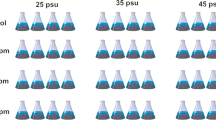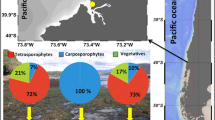Abstract
Seasonal variations of chloroplast thylakoids and plasma membrane ultrastructure and changes in some biochemical parameters (e.g., metal accumulation, photosynthetic pigments, carbohydrates, lipid peroxidation, and electrolyte leakage) were studied in fronds of Salvinia minima plants exposed to increasing concentrations of Cr(VI) in both winter and summer. Disorganization of stacked (grana) and unstacked (stroma lamellae) thylakoids was greater in winter chloroplasts than in summer chloroplasts. Plasma membrane was less affected than thylakoids. Photosynthetic pigments, lipid peroxidation, soluble sugars, and starch were affected differently in winter and summer. Our results suggest that much greater ultrastructural alterations and changes in metabolite levels occurring in winter fronds are produced by higher oxidative stress resulting from the interactive effect between low temperature, low solar irradiance, and Cr(VI) toxicity, rather than from metal accumulation per se. Seasonal differences occurring in chloroplast ultrastructure and metabolite concentrations were discussed in relation to metabolic implications. Evaluated parameters represent a relevant approach to enhance knowledge on performance and fitness of plants exposed to heavy metals under fluctuating environmental conditions. This work also indicates that selection of suitable macrophytes to remove Cr(VI) requires an additional analyzing focus on structural and metabolic interactions that occur in plants exposed to heavy metals in contrasting seasons.




Similar content being viewed by others
References
Appenroth, K. J., Keresztes, Á., Sárvári, É., Jaglarz, A., & Fischer, W. (2003). Multiple effects of chromate on Spirodela polyrhiza: electron microscopy and biochemical investigations. Plant Biology, 5, 315–323.
Aravind, P., & Prasad, M. N. V. (2005). Cadmium-zinc interactions in a hydroponic system using Ceratophyllum demersum L.: adaptive ecophysiology, biochemistry and molecular toxicology. Brazilian Journal of Plant Physiology, 17, 3–20.
Chandra, P., & Kulshreshtha, K. (2004). Chromium accumulation and toxicity in aquatic vascular plants. Botanical Review, 70, 313–327.
Choudhury, N. K., & Behera, R. K. (2001). Photoinhibition of photosynthesis: role of carotenoids in photoprotection of chloroplast constituents. Photosynthetica, 39, 481–488.
Cuello, J., & Lahora, A. (1993). Chlorophyll degradation by free radicals derived from linolenic acid in incubated barley thylakoids. Acta Botanica Neerlandica, 42, 481–490.
Daud, M.K., Mei, L., Variath, M.T., Ali, S., Li, C., Rafiq, M.T., & Zhu, S.J. (2014). Chromium (VI) uptake and tolerance potential in cotton cultivars: effect on their root physiology, ultramorphology, and oxidative metabolism. BioMed Research International, 2014, ID 975946, 12 p.
Du, Z., & Bramlage, W. J. (1992). Modified thiobarbituric acid assay for measuring lipid oxidation in sugar-rich plant tissue extracts. Journal of Agricultural and Food Chemistry, 40, 1566–1570.
Dubey, R. S. (2011). Metal toxicity, oxidative stress and antioxidative defense system in plants. In S. D. Gupta (Ed.), Reactive oxygen species and antioxidants in higher plants (pp. 177–203). Boca Raton: CRC Press Taylor & Francis Group.
Dubois, M., Gilles, K. A., Hamilton, J. K., Rebers, P. A., & Smith, F. (1956). Colorimetric method for determination of sugar and related substances. Analytical Chemistry, 28, 350–356.
Fargašová, A. (2008). Phytotoxicity of chromium and nickel. Ecological Chemistry and Engineering S, 15, 335–348.
Farmer, A. M., & Spence, D. H. N. (1987). Environmental control of the seasonal growth of the submersed aquatic macrophyte Lobelia dortmanna L. New Phytologist, 106, 289–299.
Geigenberger, P. (2011). Regulation of starch biosynthesis in response to a fluctuating environment. Plant Physiology, 155, 1566–1577.
Gibon, Y., Bläsing, O. E., Palacios-Rojas, N., Pankovic, D., Hendriks, J. H. M., Fisahn, J., et al. (2004). Adjustment of diurnal starch turnover to short days: depletion of sugar during the night leads to a temporary inhibition of carbohydrate utilization, accumulation of sugars and post-translational activation of ADP-glucose pyrophosphorylase in the following light period. The Plant Journal, 39, 847–862.
Iglesias, D. J., Lliso, I., Tadeo, F. R., & Talon, M. (2002). Regulation of photosynthesis through source: sink imbalance in citrus is mediated by carbohydrate content in leaves. Physiologia Plantarum, 116, 563–572.
Karuppanapandian, T., Pritam, B. S., Kamarul, H. A., & Manoharan, K. (2009). Chromium-induced accumulation of peroxide content, stimulation of antioxidative enzymes and lipid peroxidation in green gram (Vigna radiata L. cv. Wilczek) leaves. African Journal of Biotechnology, 8, 475–479.
Kirchhoff, H. (2013). Architectural switches in plant thylakoid membranes. Photosynthesis Research, 116, 481–487.
Lage-Pinto, F., Oliveira, J. G., Da Cunha, M., Souza, C. M. M., Rezende, C. E., Azevedo, R. A., & Vitória, A. P. (2008). Chlorophyll a fluorescence and ultrastructural changes in chloroplast of water hyacinth as indicators of environmental stress. Environmental and Experimental Botany, 64, 307–313.
Lemoine, R., La Camera, S., Atanassova, R., Dédaldéchamp, F., Allario, T., Pourtau, N., et al. (2013). Source-to-sink transport of sugar and regulation by environmental factors. Frontiers in Plant Science, 4, 272. doi:10.3389/fpls.2013.00272.
Liu, D., Zou, J., Wang, M., & Jiang, W. (2008). Hexavalent chromium uptake and its effects on mineral uptake, antioxidant defence system and photosynthesis in Amaranthus viridis L. Bioresource Technology, 99, 2628–2636.
Lütz, C. (2010). Cell physiology of plants growing in cold environments. Protoplasma, 244, 53–73.
Mahajan, P., Singh, H. P., Batish, D. R., & Kohli, R. K. (2013). Cr(VI) imposed toxicity in maize seedlings assessed in terms of disruption in carbohydrate metabolism. Biological Trace Element Research, 156, 316–322.
Maine, M. A., Suñé, N. L., & Lagger, S. C. (2004). Chromium bioaccumulation: comparison of the capacity of two floating aquatic macrophytes. Water Research, 38, 1494–1501.
Marbaniang, D., & Chaturvedi, S. S. (2014). Assessment of Cr+6 accumulation and phytoremediation potential of three aquatic macrophytes of Meghalaya, India. International Journal of Science and Research, 3, 36–42.
Muñoz, F. J., Baroja-Fernández, E., Morán-Zorzano, M. T., Viale, A. M., Etxeberria, E., Alonso-Casajús, N., & Pozueta-Romero, J. (2005). Sucrose synthase controls both intracellular ADP glucose levels and transitory starch biosynthesis in source leaves. Plant Cell Physiology, 46, 1366–1376.
Nevo, R., Charuvi, D., Tsabari, O., & Reich, Z. (2012). Composition, architecture and dynamics of the photosynthetic apparatus in higher plants. The Plant Journal, 70, 157–176.
Oliveira, H. (2012). Chromium as an environmental pollutant: insights on induced plant toxicity. Journal of Botany, 2012, ID 375843, 8 p.
Oquist, G., & Huner, N. P. A. (2003). Photosynthesis of overwintering evergreen plants. Annual Review of Plant Biology, 54, 329–355.
Paiva, L. B., de Oliveira, J. G., Azevedo, R. A., Ribeiro, D. R., Da Silva, M. G., & Vitória, A. P. (2009). Ecophysiological responses of water hyacinth exposed to Cr3+ and Cr6+. Environmental and Experimental Botany, 65, 403–409.
Pandey, V., Dixit, V., & Shyam, R. (2009). Chromium (VI) induced changes in growth and root plasma membrane redox activities in pea plants. Protoplasma, 235, 49–55.
Pfündel, E., & Pfeffer, M. (1997). Modification of photosystem I light harvesting of bundle-sheath chloroplasts occurred during the evolution of NADP-malic enzyme C4 photosynthesis. Plant Physiology, 114, 145–152.
Pilon, J., & Santamaría, L. (2001). Seasonal acclimation in the photosynthetic and respiratory temperature responses of three submerged freshwater macrophyte species. New Phytologist, 151, 659–670.
Prado, C., Rosa, M., Pagano, E., Hilal, M., & Prado, F. E. (2010). Seasonal variability of physiological and biochemical aspects of chromium accumulation in outdoor-grown Salvinia minima. Chemosphere, 81, 584–593.
Prado, F. E., González, J. A., Boero, C., & Sampietro, A. R. (1998). A simple and sensitive method for determining reducing sugars in plant tissues. Application to quantify the sugar content in quinoa (Chenopodium quinoa Willd.) seedlings. Phytochemical Analysis, 9, 58–62.
Prasad, M. N. V. (2007). Aquatic plants for phytotechnology. In S. N. Singh & R. D. Tripathi (Eds.), Environmental bioremediation technologies (pp. 257–274). Heidelberg: Springer.
Rai, P. K. (2008). Heavy metal pollution in aquatic ecosystems and its phytoremediation using wetland plants: an ecosustainable approach. International Journal of Phytoremediation, 10, 133–160.
Ramel, F., Birtic, S., Cuiné, S., Triantaphylidès, C., Ravanat, J. L., & Havaux, M. (2012). Chemical quenching of singlet oxygen by carotenoids in plants. Plant Physiology, 158, 1267–1278.
Rodriguez, E., Santos, C., Azevedo, R., Moutinho-Pereira, J., Correia, C., & Dias, M. C. (2012). Chromium (VI) induces toxicity at different photosynthetic levels in pea. Plant Physiology and Biochemistry, 53, 94–100.
Rojdestvenski, I., Ivanov, A. G., Cottam, M. G., Borodich, A., Huner, N. P. A., & Öquist, G. (2002). Segregation of photosystems in thylakoid membranes as a critical phenomenon. Biophysical Journal, 82, 1719–1730.
Rosa, M., Hilal, M., González, J. A., & Prado, F. E. (2004). Changes in soluble carbohydrates and related enzymes induced by low temperature during early developmental stages of quinoa (Chenopodium quinoa) seedlings. Journal of Plant Physiology, 161, 683–689.
Savitch, L. V., Harney, T., & Huner, N. P. A. (2000). Sucrose metabolism in spring and winter wheat in response to high irradiance, cold stress and cold acclimation. Physiologia Plantarum, 108, 270–278.
Shanker, A. K., Cervantes, C., Loza-Tavera, H., & Avudainayagam, S. (2005). Chromium toxicity in plants. Environment International, 31, 739–753.
Santos, C., & Rodriguez, E. (2012). Review on some emerging endpoints of chromium (VI) and lead phytotoxicity. In: J. Mwoeia (Ed.), Botany, (pp. 61–82). Croatia: InTech.
Singh, H. P., Mahajan, P., Kaur, S., Batish, D. R., & Kohli, R. K. (2013). Chromium toxicity and tolerance in plants. Environmental Chemical Letters, 11, 229–254.
Singh, H. P., Batish, D. R., Kohli, R. K., & Arora, K. (2007). Arsenic-induced root growth inhibition in mung bean (Phaseolus aureus Roxb.) is due to oxidative stress resulting from enhanced lipid peroxidation. Plant Growth Regulation, 53, 65–73.
Sinha, S., Saxena, R., & Singh, S. (2002). Comparative studies on accumulation of Cr from metal solution and tannery effluent under repeated metal exposure by aquatic plants: its toxic effects. Environmental Monitoring and Assessment, 80, 17–31.
Solymosi, K., & Bertrand, M. (2010). Heavy metals and plastid metabolism. In M. Pessarakli (Ed.), Handbook of plant and crop stress (3rd ed., pp. 675–711). Boca Raton: CRC Press Taylor & Francis Group.
Staehr, P. A., & Borum, J. (2011). Seasonal acclimation in metabolism reduces light requirements of eelgrass (Zostera marina). Journal of Experimental Marine Biology and Ecology, 407, 139–146.
Taiz, L., & Zeiger, E. (2006). Plant physiology (4th ed.). Sunderland: Sinauer Associates, Inc.
Telfer, A. (2014). Singlet oxygen production by PSII under light stress: mechanism, detection and the protective role of β-carotene. Plant and Cell Physiology, 55, 1216–1223.
Triantaphylidès, C., Krischke, M., Hoeberichts, F. A., Ksas, B., Gresser, G., Havaux, M., Van Breusegem, F., & Mueller, M. J. (2008). Singlet oxygen is the major reactive oxygen species involved in photooxidative damage to plants. Plant Physiology, 148, 960–968.
Vajpayee, P., Rai, U. N., Ali, M. B., Tripathi, R. D., Yadav, V., Sinha, S., & Singh, S. N. (2001). Chromium-induced physiologic changes in Vallisneria spiralis L. and its role in phytoremediation of tannery effluent. Bulletin of Environmental Contamination and Toxicology, 67, 246–256.
Vass, I. (2012). Molecular mechanisms of photodamage in the photosystem II complex. Biochimica et Biophysica Acta, 1817, 209–217.
Zayed, A. M., & Terry, N. (2003). Chromium in the environment: factors affecting biological remediation. Plant and Soil, 249, 139–156.
Acknowledgments
This work was supported by Grant (G437) from Consejo de Investigaciones de la Universidad Nacional de Tucuman (CIUNT) and by Grant (PIP11/265) from Consejo Nacional de Investigaciones Científicas y Técnicas (CONICET). CP is a fellow from CONICET.
Author information
Authors and Affiliations
Corresponding author
Rights and permissions
About this article
Cite this article
Prado, C., Prado, F.E., Pagano, E. et al. Differential Effects of Cr(VI) on the Ultrastructure of Chloroplast and Plasma Membrane of Salvinia minima Growing in Summer and Winter. Relationships With Lipid Peroxidation, Electrolyte Leakage, Photosynthetic Pigments, and Carbohydrates. Water Air Soil Pollut 226, 8 (2015). https://doi.org/10.1007/s11270-014-2284-3
Received:
Accepted:
Published:
DOI: https://doi.org/10.1007/s11270-014-2284-3




